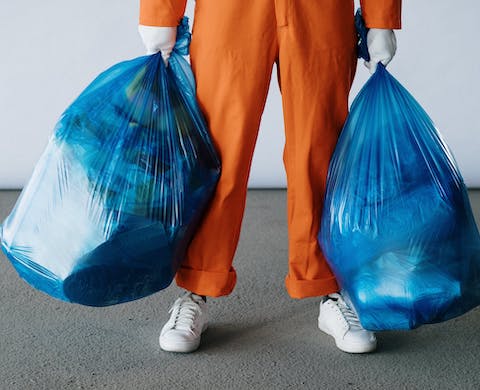The fashion industry is causing a big problem with all the clothes that get thrown away. Some materials, like cotton and wool, can break down naturally over time. But others, like polyester and nylon, can’t. The Biomimicry Institute is trying to find a way to break down these materials using natural things like enzymes or bacteria. They want to make it easier to get rid of old clothes and maybe even make new materials.
“Fast fashion” is a term for cheap clothes that get made and thrown away really quickly. Only 1% of these clothes actually get recycled into new ones. This is bad because it creates a lot of pollution and hurts animals and plants. Lycra, a company that makes stretchy fabric, wants to use a new material called Qira instead of the usual stuff made from oil. This could make their products much better for the environment.
Some other companies are also trying to find new ways to make clothes without making so much waste. MycoWorks makes a material that looks like leather from mushrooms. Faber Futures is studying a bacteria that lives in soil to use for dyeing clothes. Spinnova turns wood into fabric and wants to make a lot of it without hurting the environment. But for all of these ideas to work, people need to start recycling their old clothes instead of throwing them away.
Even though people are trying to fix the problem of clothing waste, there are still some challenges. Some stores have programs where you can bring back old clothes, but a lot of the time those clothes just get destroyed or sent to other countries. To really solve the problem, we need to change the way we think about clothes and how we make them.
Original news source: The hunt for a new way to tackle clothing waste (BBC)
Listen
Slow
Normal
Fast
Group or Classroom Activities
Warm-up Activities:
– News Summary
Instructions: Divide the class into small groups. Assign each group a specific aspect of the article to focus on (e.g. the fashion industry’s impact on the environment, innovative solutions to clothing waste, challenges in recycling clothes). Each group should then create a brief news summary, highlighting the key points of their assigned aspect. After a designated amount of time, have each group share their news summary with the class.
– Opinion Poll
Instructions: Have the class form pairs or small groups. Give each group a list of statements related to the article (e.g. “Recycling old clothes is an effective solution to the problem of clothing waste,” “Fast fashion is a necessary evil in today’s society”). Each group should discuss each statement and rate their level of agreement or disagreement on a scale of 1-5. After the discussion, ask each group to share their opinions and the reasons behind their ratings.
– Sketch It
Instructions: Divide the class into pairs. Give each pair a specific aspect of the article to illustrate (e.g. the process of breaking down materials using natural enzymes, the impact of fast fashion on the environment). Each pair should create a sketch or diagram to visually represent their assigned aspect. After a designated amount of time, have each pair present their sketches to the class, explaining their choices and the main ideas behind their illustrations.
– Vocabulary Pictionary
Instructions: Write down a list of vocabulary words from the article (e.g. biomimicry, polyester, recycling). Divide the class into two teams. One member from each team takes turns coming to the front of the class and drawing a word from the list without speaking. The rest of their team members must guess the word within a time limit. The team that guesses the most words correctly wins.
– Future Predictions
Instructions: Have the class form pairs or small groups. Ask each group to discuss and make predictions about the future of the fashion industry and its impact on the environment based on the information in the article. Each group should come up with at least three predictions, supported by their reasoning. After the discussion, have each group share their predictions with the class and facilitate a class discussion on the topic.
Comprehension Questions:
1. What is the problem that the fashion industry is causing with clothes?
2. Why can’t certain materials like polyester and nylon break down naturally?
3. What is the Biomimicry Institute trying to do with these materials?
4. What does the term “fast fashion” refer to?
5. Why is it bad that only 1% of fast fashion clothes get recycled into new ones?
6. What is Qira and how could it improve the environmental impact of stretchy fabric?
7. Name one company mentioned in the article that is finding new ways to make clothes without creating waste.
8. What needs to happen for all of these ideas to be successful in reducing clothing waste?
Go to answers ⇩
Listen and Fill in the Gaps:
The fashion industry is causing a big problem with all the (1)______ that get thrown away. Some (2)______, like cotton and wool, can break down naturally over time. But others, like (3)______ and nylon, can’t. The (4)______ Institute is trying to find a way to break down these materials using natural things like enzymes or bacteria. They want to make it easier to get rid of old clothes and maybe even make new materials.
“Fast fashion” is a term for cheap clothes that get made and thrown away really quickly. Only 1% of these clothes actually get (5)______ into new ones. This is bad because it creates a lot of pollution and hurts animals and plants. Lycra, a company that (6)______ stretchy fabric, (7)______ to use a new material called Qira instead of the usual (8)______ made from oil. This could make their products much better for the environment.
Some (9)______ companies are also trying to find new ways to make clothes without making so much waste. (10)______ makes a material that looks like leather from mushrooms. Faber Futures is (11)______ a bacteria that lives in soil to use for dyeing clothes. Spinnova (12)______ wood into fabric and wants to make a lot of it without hurting the environment. But for all of these ideas to work, people need to start recycling their old clothes instead of (13)______ them away.
Even though people are trying to fix the problem of clothing waste, there are still some (14)______. Some stores have programs where you can bring back old clothes, but a lot of the time those clothes just get (15)______ or sent to other countries. To really solve the problem, we need to change the way we (16)______ about clothes and how we make them.
Go to answers ⇩
Discussion Questions:
Students can ask a partner these questions, or discuss them as a group.
1. What is “fast fashion” and why is it a problem?
2. How would you feel if your old clothes could be broken down and turned into new materials?
3. Do you like the idea of using mushrooms to make fabric? Why or why not?
4. What do you think about the idea of using bacteria from soil to dye clothes?
5. How would you feel if all clothes were made from wood instead of cotton or polyester?
6. Do you think people should recycle their old clothes? Why or why not?
7. What challenges do you think companies face when trying to find solutions for clothing waste?
8. How would you feel if your old clothes were destroyed or sent to another country instead of being recycled?
9. Do you think changing the way we think about clothes is important? Why or why not?
10. How would you feel if you had to buy clothes that were made from recycled materials only?
11. What are some other ways you can think of to reduce clothing waste?
12. How would you feel if you had to pay extra for clothes that were environmentally friendly?
13. Do you think it’s important for companies to take responsibility for the waste they create? Why or why not?
14. How would you feel if all clothes were made from natural materials that could easily break down?
15. What do you think is the biggest challenge in solving the problem of clothing waste? Why?
Individual Activities
Vocabulary Meanings:
Match each word to its meaning.
Words:
1. fashion
2. materials
3. recycled
4. pollution
5. environment
6. leather
7. bacteria
8. challenges
Meanings:
(a) A material made from animal skin
(b) Used again to make something new
(c) The industry that makes and sells clothes
(d) The substances used to make something
(e) Tiny living things that can be helpful or harmful
(f) Difficulties or problems that need to be overcome
(g) The natural world and the things in it
(h) Harmful substances that make the air, water, or land dirty
Go to answers ⇩
Multiple Choice Questions:
1. What is the Biomimicry Institute trying to do with clothing materials like polyester and nylon?
(a) Use them to make new materials
(b) Find a way to break them down using natural things like enzymes or bacteria
(c) Recycle them into new clothes
(d) Throw them away
2. What is “fast fashion”?
(a) Expensive clothes that last a long time
(b) Clothes made from natural materials
(c) Clothes made from recycled materials
(d) Cheap clothes that get made and thrown away quickly
3. Why is it bad that only 1% of fast fashion clothes get recycled into new ones?
(a) It makes the clothes more expensive
(b) It makes the clothes less fashionable
(c) It creates a lot of pollution and hurts animals and plants
(d) It wastes natural resources
4. What is Qira?
(a) A new material made by Lycra that could be better for the environment
(b) A type of bacteria used for dyeing clothes
(c) A material made from mushrooms that looks like leather
(d) A company that turns wood into fabric
5. What is MycoWorks?
(a) A company that turns wood into fabric
(b) A company that uses bacteria to dye clothes
(c) A company that recycles old clothes into new ones
(d) A company that makes a material from mushrooms that looks like leather
6. What is one challenge in fixing the problem of clothing waste?
(a) People don’t like the new materials being used for clothes
(b) The Biomimicry Institute is not finding any solutions
(c) Some stores destroy or send old clothes to other countries instead of recycling them
(d) Fast fashion clothes are too expensive to recycle
7. What does Spinnova do?
(a) Makes a material from mushrooms that looks like leather
(b) Turns wood into fabric and wants to make a lot of it without hurting the environment
(c) Uses bacteria to dye clothes
(d) Recycles old clothes into new ones
8. What needs to change in order to solve the problem of clothing waste?
(a) The way we think about clothes and how we make them
(b) The way we recycle old clothes
(c) The way we buy clothes
(d) The way we throw away clothes
Go to answers ⇩
True or False Questions:
1. Various companies, such as MycoWorks and Spinnova, are not researching and developing sustainable alternatives to traditional clothing materials.
2. The fashion industry is not contributing to a significant problem with clothing waste.
3. Fast fashion contributes to pollution and harms animals and plants.
4. However, materials like polyester and nylon can break down naturally.
5. The Biomimicry Institute is working on finding ways to break down these non-biodegradable materials using natural substances like enzymes or bacteria.
6. Lycra, a company that produces stretchy fabric, is exploring the use of a new material called Qira, which could be more environmentally friendly than the usual oil-based materials.
7. “Fast fashion” refers to expensive clothes that are carefully crafted and treasured, with 99% of these clothes being recycled into new ones.
8. Certain materials used in clothing, like cotton and wool, can naturally break down over time.
Go to answers ⇩
Write a Summary:
Write a summary of this news article in two sentences.
Check your writing now with the best free AI for English writing!
Writing Questions:
Answer the following questions. Write as much as you can for each answer.
Check your answers with our free English writing assistant!
1. What is the problem with the clothes that the fashion industry produces?
2. Why can’t materials like polyester and nylon break down naturally over time?
3. What is the Biomimicry Institute trying to do to solve the problem of clothing waste?
4. What is “fast fashion” and why is it bad for the environment?
5. What are some alternative materials and methods that companies are using to make clothes more sustainable?
Answers
Comprehension Question Answers:
1. What is the problem that the fashion industry is causing with clothes?
The problem is that a lot of clothes get thrown away, which creates waste and pollution.
2. Why can’t certain materials like polyester and nylon break down naturally?
These materials are made from synthetic fibers that don’t break down easily like natural fibers do.
3. What is the Biomimicry Institute trying to do with these materials?
They are trying to find ways to break down these materials using natural things like enzymes or bacteria.
4. What does the term “fast fashion” refer to?
“Fast fashion” refers to cheap clothes that are made quickly and then thrown away.
5. Why is it bad that only 1% of fast fashion clothes get recycled into new ones?
It’s bad because it creates a lot of pollution and harms animals and plants.
6. What is Qira and how could it improve the environmental impact of stretchy fabric?
Qira is a new material made by Lycra that could replace the usual fabric made from oil. It could make stretchy fabric more environmentally friendly.
7. Name one company mentioned in the article that is finding new ways to make clothes without creating waste.
One company mentioned is MycoWorks, which makes a material that looks like leather from mushrooms.
8. What needs to happen for all of these ideas to be successful in reducing clothing waste?
People need to start recycling their old clothes instead of throwing them away.
Go back to questions ⇧
Listen and Fill in the Gaps Answers:
(1) clothes
(2) materials
(3) polyester
(4) Biomimicry
(5) recycled
(6) makes
(7) wants
(8) stuff
(9) other
(10) MycoWorks
(11) studying
(12) turns
(13) throwing
(14) challenges
(15) destroyed
(16) think
Go back to questions ⇧
Vocabulary Meanings Answers:
1. fashion
Answer: (c) The industry that makes and sells clothes
2. materials
Answer: (d) The substances used to make something
3. recycled
Answer: (b) Used again to make something new
4. pollution
Answer: (h) Harmful substances that make the air, water, or land dirty
5. environment
Answer: (g) The natural world and the things in it
6. leather
Answer: (a) A material made from animal skin
7. bacteria
Answer: (e) Tiny living things that can be helpful or harmful
8. challenges
Answer: (f) Difficulties or problems that need to be overcome
Go back to questions ⇧
Multiple Choice Answers:
1. What is the Biomimicry Institute trying to do with clothing materials like polyester and nylon?
Answer: (b) Find a way to break them down using natural things like enzymes or bacteria
2. What is “fast fashion”?
Answer: (d) Cheap clothes that get made and thrown away quickly
3. Why is it bad that only 1% of fast fashion clothes get recycled into new ones?
Answer: (c) It creates a lot of pollution and hurts animals and plants
4. What is Qira?
Answer: (a) A new material made by Lycra that could be better for the environment
5. What is MycoWorks?
Answer: (d) A company that makes a material from mushrooms that looks like leather
6. What is one challenge in fixing the problem of clothing waste?
Answer: (c) Some stores destroy or send old clothes to other countries instead of recycling them
7. What does Spinnova do?
Answer: (b) Turns wood into fabric and wants to make a lot of it without hurting the environment
8. What needs to change in order to solve the problem of clothing waste?
Answer: (a) The way we think about clothes and how we make them
Go back to questions ⇧
True or False Answers:
1. Various companies, such as MycoWorks and Spinnova, are not researching and developing sustainable alternatives to traditional clothing materials. (Answer: False)
2. The fashion industry is not contributing to a significant problem with clothing waste. (Answer: False)
3. Fast fashion contributes to pollution and harms animals and plants. (Answer: True)
4. However, materials like polyester and nylon can break down naturally. (Answer: False)
5. The Biomimicry Institute is working on finding ways to break down these non-biodegradable materials using natural substances like enzymes or bacteria. (Answer: True)
6. Lycra, a company that produces stretchy fabric, is exploring the use of a new material called Qira, which could be more environmentally friendly than the usual oil-based materials. (Answer: True)
7. “Fast fashion” refers to expensive clothes that are carefully crafted and treasured, with 99% of these clothes being recycled into new ones. (Answer: False)
8. Certain materials used in clothing, like cotton and wool, can naturally break down over time. (Answer: True)
Go back to questions ⇧













